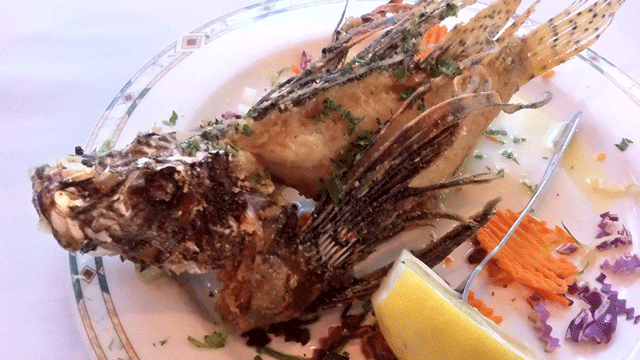
(Andy Newman/Florida Keys News Bureau)
Along the Atlantic Coast and into the Caribbean Sea and Gulf of Mexico, there’s a new fish in town. It’s not exactly welcome in the waters, but it’s finding a wider fan base among diners and restaurateurs.
Lionfish isn’t your standard restaurant seafood fare like halibut, salmon, or tuna. But thanks to a campaign to rid coastal waters of the invasive and potentially devastating species, chefs from the U.S. Virgin Islands to the Bahamas to the Carolinas are dreaming up new and delicious ways to put it on the menu.
The Indo-Pacific natives don’t belong in these waters, and with no natural predators, have for a couple of decades they’ve been populating the seas like rabbits. With their "manes" of venom-tipped spines, they're not considered food by those who live in their native habitat, and until recently were mainly kept as exotic pets in the U.S. They're voracious eaters, and environmental agencies fear they will eat their way through local juvenile fish populations if gone unchecked, ultimately destroying the health of our reefs and fisheries.
Last August, the National Oceanic and Atmospheric Administration (NOAA) launched Eat Sustainable, Eat Lionfish, a program aimed to help halt their spread, and since then restaurants have taken up the cause by finding ways to prepare the beautiful but venomous creature.
The Reef Environmental Education Foundation (REEF), based in Key Largo, Fla., joined NOAA’s efforts by educating the public about capturing and handling the fish, whose feathery spines can kill its prey and cause pain and illness to humans. The organization educates through workshops and by publishing the Lionfish Cookbook.
“The [Eat Lionfish campaign] is a major incentive and a way to provide access to information about the lionfish invasion and how to handle the fish,” said Lad Akins, cookbook co-author and REEF’s director of special projects. “One of the best incentives is turning it into a food source.”
Because of its bad rap as a fish fierce as its name, the public needs some convincing, said Akins.
“There still is a little bit of a learning curve,” he said. “Most view it with more curiosity than fear. After the first bite, you can see it on their faces. It’s an excellent fish. Kind of like hogfish – light and delicately flavored.”
Catching the fish isn't hard. Fishermen capture the fish in nets. Lobster fishermen in the Florida Keys and trap fishermen in the Caribbean find them in their traps and sell them as by-catches. Divers spear them, and the market has developed special weapons and puncture-proof hand protection for the new sport.
“Our dive boat goes out frequently, and when they do they always are on the hunt for lionfish,” said Michael A. Weber, general manager of the Bimini Big Game Club in the Bahamas, where Panko-Crusted Lionfish Nuggets have become a fixture on the appetizer menu.
“[Lionfish] are easy to get as they have no enemies, are not fast, and are not afraid of anything, so the taking is fairly easy,” he said.
But the cleaning and preparation takes a bit of skill. Weber's chefs use scissors and surgeon’s gloves to remove the offensive spines before cleaning and filleting the fish, he said.
Akins says that’s one way to do it, or just be careful when handling them. “Cooking also denatures the venom,” he said, adding that the Fish House Encore restaurant in Key Largo has developed a specialty fried whole lionfish appetizer with the spines still intact – an impressive presentation.
Another Keys restaurant, Kev’s Café in Islamorada, serves a Southwestern-style Lionfish Chowder. The Lionfish Cookbook gives instructions for such dishes as Lionfish Nachos, Spicy Lionfish, and, Akins’ favorite, Lionfish Ceviche.
“There’s quite a demand both in local restaurants as well as big city restaurants like New York and Washington,” said Akins.
Sea To Table, an organization that connects fishermen to restaurant markets, is dipping its toe into the lionfish trade, said marketing and media assistant Michelle Kiefer.
“We have been trying to develop it in Mexico, but it’s a little tricky,” she said. “Basically invasive species like that is not something fishermen work with regularly, so they don’t know its schooling habits and such. But chefs we work with are really interested in it because it’s good for the environment and unusual and exotic.”
The lionfish prices out at $16 to $18 per pound, Kiefer said, compared to the about $15 a pound that the web site was citing for mahi mahi and yellowfin tuna.
At the Key Largo Conch House in the Florida Keys, the Dreaver family serves Lionfish Benedict, Lionfish Tacos, and special dinners such as Grilled Lionfish with Avocado Salsa or Coconut Macadamia Lionfish with Orange Glaze.
“It’s more your high-end fish due to it’s harder to come by and to prepare,” said Jon Dreaver.
The restaurant will typically charge $26 to $29 for a lionfish dinner compared to $17 to $23 for mahi mahi or grouper, he said.
“The main purpose we serve it is to eradicate it from the local area… because we’re the only predator the lionfish has got,” he added. “People think of it as a poisonous fish, but it’s not. It’s venomous, and only in its spines. It’s one of the best-tasting fish you’ll come across.”
At Fleet Landing Restaurant in Charleston, S.C., Executive Chef Drew Hedlund has served lionfish for special events both potato-encrusted then pan-fried and flash-fried with lemon-ginger sauce. He says, however, the lionfish’s newfound renown is driving up prices.
“Our main goal was just taking them off the reef, not being trendy,” he said. “They’re challenging our other fish for their food supply.”
“We are trying to reduce the impact on native species of fish,” said Akins. “[The lionfish is] not likely to be overfished, but I’m an optimist. We would hope to get it overfished, but it’s not likely we’ll ever eradicate it.”
